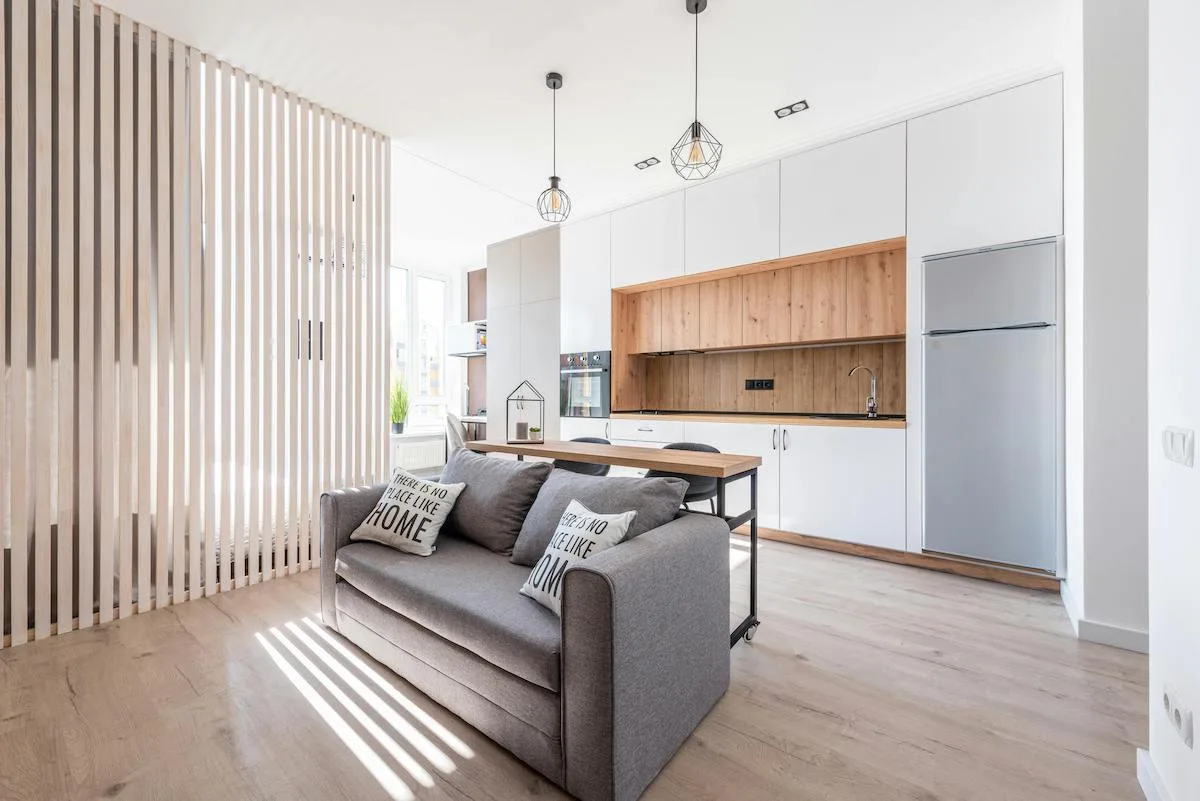Finding your first apartment can feel like an overwhelming endeavor. Understanding the ins and outs of how to get an apartment can help you avoid some common mistakes and skip right to the excitement of settling into a quality community. While young renters typically face the steepest learning curve, even older renters can run into these pitfalls if it’s their first rental experience. Proper preparation will help ensure that you can move in confidently and enjoy your entire lease term with no regrets.
Here’s our step-by-step guide for how to find an apartment when you’re new to apartment living.

Follow these steps when searching for your first apartment.
- Understand what you can afford
It’s important to draw up a detailed budget before you move out on your own for the first time. Check your pay stubs or deposit amounts for the last few months to get a solid idea of how much you can expect to make each month. This is especially important if you have irregular hours or rely heavily on tips. With your income in hand, you can begin exploring how much you can afford to spend.
Start by listing your predictable recurring expenses. This includes things like a cell phone bill or car payment. Soon, it will also include rent. Next, you’ll need to calculate your variable expenses. This is a bit trickier, so you may need to keep your receipts for a few months or comb through your bank statements. Make an honest assessment of what you spend on groceries, gas, toiletries, and entertainment.
Compare your income to your current expenses to determine what’s left for your apartment. Keep in mind that your apartment expenses will typically include:
Rent
Utilities
Internet
Water
Trash
Some property managers may also require renter’s insurance. This coverage is an important consideration even when it’s not mandatory, as it can help protect you from the steep expenses associated with theft, fire, and other hazards. Consider pricing renter’s insurance when you’re working out your apartment budget as well.
Experts have often recommended you spend 30% of your monthly income on rent, but that might not be realistic in hot markets like New York City or San Francisco. It might help to research common rental requirements in your market to learn what a realistic budget is for you. Some property managers require renters to earn three times the monthly rent to qualify for a lease, so consider rental stipulations when researching apartments. - Decide how many bedrooms you need
Before you start hunting, figure out what your living arrangement is. If you’re moving alone, reflect on if you want or need roommates. If you learned in your budget breakdown that you can’t quite afford the standard cost of a studio or one-bedroom apartment in your area, you aren’t out of luck. Ask around with friends, colleagues, and community groups to find potential roommates, so you can split the cost. Before moving in with someone, make sure you can trust them. It’s important to live with people who have compatible living habits and a history of paying bills on time.
If you’re moving with your partner, decide if you want one bedroom or multiple. Many couples enjoy having a spare bedroom to use as a guest bedroom or an office. If you’re moving with kids, are they sharing a room or will each little one have their own space? Weigh your preferences with your budget to determine your target apartment size. - Choose the right neighborhood
The neighborhood you choose will have a big impact on your rent. Consider your wants and needs carefully to make sure you feel comfortable and safe in your environment. Some things to look into include:
Crime rate
Distance to places like work and school
Nearby amenities like stores and gas stations
Noise levels, particularly at night
Demographics
Entertainment
Young adults moving into their first apartments may prefer to live in an area with a younger demographic and more vibrant nightlife. However, if you’re working long hours or raising young children, you may prioritize things like quiet streets and proximity to playgrounds.
Consider the time and cost of your daily commute. Is a cheaper apartment really worth it if it doubles your gas expenses or forces you to spend an extra hour on the bus? Think about all the places you like to visit and try to find a neighborhood that puts you within a reasonable distance of these. - Time your move-in
If you’re targeting a coveted apartment community, you may find that there’s a waiting list for your desired unit. You should typically start looking for an apartment about 60 days before your move-in date. This will give you time to compare your options, find the right community, and put your name down for the unit that you want. You can certainly find an apartment on a shorter timeline, but you may find your options are more limited. Starting sooner may allow you to target things like a particular floor or side of the complex.
- Compare apartment amenities
Evaluate all the amenities of each apartment unit and community as you compare your options. If you’re considering moving into a complex, look for community features like:
Clubhouses
Pools
Fitness facilities
Dog parks
Playgrounds
Pet washing stations
Elevators
Garages or covered parking
Laundry facilities
Availability, quality, and price of internet providers
In each unit, consider features like:
Number and size of closets
Number of bathrooms
Availability of showers and tubs
Amount of natural light
Quality of flooring and surfaces
Quality of appliances, like the oven and refrigerator
Porches, balconies, or fenced yards
Size, quality, and availability of appliances
Laundry facilities
Number and size of cabinets and drawers
Amount of counter space in the kitchen and bathroom
Flooring type and age
Square footage throughout
Measurements in each room
It’s easy to overlook small details, but something like tiny kitchen drawers that aren’t large enough for a silverware divider can become really frustrating once you’ve moved into your new place. You should tour the floor plan that you’re considering. If possible, tour the exact unit that you’d be renting. If that unit is occupied, make sure you ask about any variations between the unit you’re touring and the one that you’ll live in. Model units often have updated features that aren’t necessarily included throughout the complex.
If you have any large pieces of furniture, like an L-shaped couch or king-size bed, get the exact measurements and take a measuring tape with you when you tour the apartment. Consider where your furniture will sit and make sure you choose an apartment that will comfortably fit everything you own. It might also help to speak with current renters if they’re around while you’re touring the property. Asking people who live in the community how they feel about the property, the management, and the neighborhood might help you get an honest view of the apartment you’re considering. - Submit an application
Once you’ve found an apartment that you’re happy with, it’s time to gather your documents and submit an application to the property manager. Each property might require slightly different information and materials, but here are some things property management might ask you to submit:
An application form with contact information and details about all renters
Proof of identification, such as your driver’s license, passport, or Social Security card
Letters of reference
Proof of steady income, like pay stubs or tax returns
Proof of savings via bank statements or account screenshots
Property managers also usually run a credit check and background check to ensure you’re responsible. Since this is your first apartment, the more you can submit to prove you’re a worthwhile candidate, the better. For example, you might not have letters of reference from past property managers, but you can ask your boss at work to write a reference explaining that you’re responsible, dependable, and always show up on time. Showing extra proof of your financial stability may help, too.
If you have little credit and rental history, it might help your chances to find a guarantor. A guarantor is another person with excellent credit who signs alongside you and agrees to pay on your behalf if you become delinquent. Essentially, it’s someone to back you up, so the property manager is more comfortable renting to you. Consider asking a parent, spouse, or close friend. Remember to choose someone with whom you have a close and trusting relationship because it’s a pretty serious agreement. - Review the lease terms
You’ll need to review the lease terms before you sign a contract. Make sure you read through this document carefully. Don’t skip any of the fine print. Some important points to look for in the lease include:
Rent amount
Deposit amount
Terms upon which the deposit is refundable
Date rent is due each month
Available grace period for rent
Late charges if you cannot pay rent on time
Pet policies, if applicable
Utilities that are included or billed separately
Guest policy
Rules for subletting
Rules for decorating or changing your unit
Terms for terminating or renewing the lease
Your maintenance responsibilities and those of the property manager
Requirements for renter’s insurance
Final thoughts
Finding your first apartment is an exciting endeavor. Following these guidelines, you can locate the best spot for you. Once you’ve found the ideal apartment, you can start planning your move, packing your boxes, and getting excited about your next chapter.



